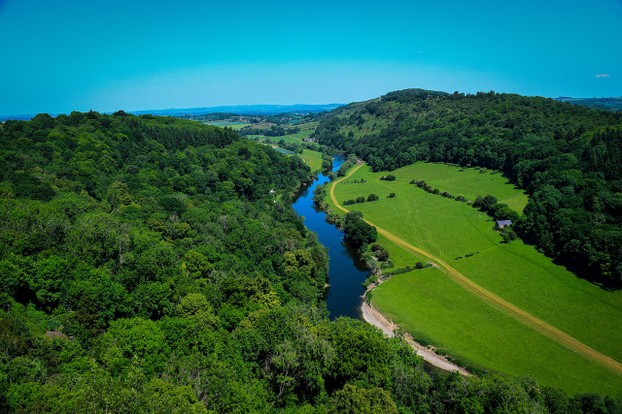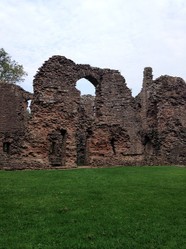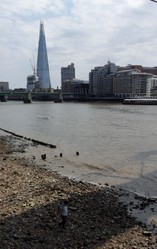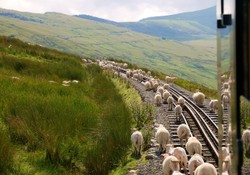So far I have concentrated on the northern half of the Marches, but south of Shropshire you enter the lovely county of Herefordshire. This county is separated from its eastern neighbour Worcestershire by the Malvern Hills, a narrow, but steep range of hills composed of old, hard precambrian rock. This rock is so old that it has been leached of all its nutrients by eons of pluviation, and the result is a mineral water that is very near to purity and so is excellent for cocktails.Herefordshire is quintessentially the land of cyder apples. I use the old spelling intentionally because I am referring to the traditonal cider apple that was pressed and brewed into a famous alcoholic drink. There has been some loss of orchards in the last half century, but recently replanting has begun and tradition has been restored.
There is a place called the Golden Valley, where the micro-climate is said to be exactly right for cyder apple production. The term gold is a misnomer. Through the valley runs the river Dore, Dore being an old Celtic name derived from the word for water, but the incoming Normans in 1066 thought that it derived from the French D'or, meaning gold.The Dore is a tributary of the mighty Severn, England's longest river, which flows through Shropshire and Herefordshire as it powers its course from its Welsh birthplace on Plynlimon.The Severn is a powerful river prone at times to Winter flooding, especially down stream as the Severn's tributaries swell its waters.
But a really delightful part of this lovely part of the world is the Wye Valley. The river Wye makes its steady course from its fountain the Welsh mountains until it merges with the Severn. On its path it passes through some lovely scenery. I canoed the route as it passes through farm and woodland, with the summer sun glinting on its generally peaceful waters.The Wye takes you through the city of Hereford, whose mediaeval cathedral houses an orginal copy of the Magna Carta and the Mapppa Mundi, a mediaeval map of the world as people of that age imagined it to be. The picture above shows you Symond's Yat, meaning Symond's Gate, a narrow gorge through which the Wye gently flows.One bank is in Herefordshire. while the other is in Gloucestershire.The photograph is taken from Symond's Rock, a vantage point and beauty spot. It is a memorable place.
The picturesque movement in art began as a form of landscape painting that attempted to capture the beauty and grandeur of this area. Nature and dramatic,often ruined buildings,notably castles and monasteries, were captured in artistic productions round here. The stark and haunting remains of Tintern Abbey stand as a silent reminder of injustice. Words worth wrote one of his most inspiring poems there, and in it he attempted to capture the sense of divine presence that permeates nature.
I have attempted to give readers a sip of the cup of beauty that permeates the west of England and the Welsh borders, a starter at the feast of lovely landscape that awaits the traveĺer who comes to visit. But please be aware,that I am describing it as it is in Summer. My Wizzley article " A Night in the Snow" describes a bad experience fortunately survived. Only yesterday [November 2022]some officer cadets training in the hills above the Golden Valley were helicoptered to hospital after succumbing to cold and exhaustion.Even lovely places have their dangers.
I am an Amazon associate and hope to earn money from qualifying purchases on this page.








 Pilgrimage. A reviewon 06/15/2025
Pilgrimage. A reviewon 06/15/2025
 Leo the Fourteenthon 05/09/2025
Leo the Fourteenthon 05/09/2025
 The Melsonby Hoardon 03/25/2025
The Melsonby Hoardon 03/25/2025



Comments
Yes. Imhave seennthevsalvaged pillarsvin the porch
Thank you for your comment June 17, 2023, in answer to my previous question June 16, 2023.
Online sources to Ribchester inn searches draw up Ribchester Arms and White Bull Hotel.
There's no information about salvaged Roman pillars.
Might either one be the Ribchester inn with the Roman-pillared porch?
Taking of ancient building materials from Roman remains was common until the Middle Ages and even a a relatively modern building such as the inn at the Roman site of Ribchester has two salvaged Roman pillars in its porch. The inn is probably eighteenth century.
Thank you!
Your answer about surreptitious digs was as expected for eastern pond-siders, what with what tennis champion Arthur Ashe voiced, in his autobiography, about your appreciation of flowers, manners, rituals and traditions.
It probably would be quite true here, even as there would be some rare exceptions, such as a few people perhaps having taken in the 19th and early 20th centuries a few here, a few there, of some of the building materials from some early houses -- still extant 300 to 350 years later, in the 21st century! -- from colonial American times.
When a contract for public works is awarded there is a statutory obligation upon the companies performing the digging to perform an archaeological investigation. I do not know of any surreptitious digs happening.
The United States controls digging around utilities, be they telephone poles, traffic lights, transformers, etc. That ends up perhaps more enforceable than digging around, into, under historical sites just because of the formers' visibility along roadways.
Does the United Kingdom enforce no digging around artifacts and utilities? Or would it be possible to quietly dig bit by bit until someone reaches an underlying Roman road and takes some parts of it for illegal gain?
The ancient fords have been replaced by modern bridges.
Street, as you know, is a loan word from Latin, strada being modified into the word street. Most of the significant Roman roads are called street, though some such as the Foss Way,are not. Some are still in the original form, with the ancient surface exposed. But roads like the one near my house are major routes between modern cities that need to have their surfaces repaired and at times they need to widen the road. The only way in which we can recognize the Roman origin of my local road is that it runs straight for many miles and because it runs between two Roman forts: Manchester and Chester.
There was a ford on the river called Trafford. We called the borough Trafford to distinguish it from the ancient town of Stretford, which is included in Trafford as a subtown.it used to have its own municipal adsministration, but was reorganised.
It would be wrong to say that the name Stretford is a version of Stratford, both are the same word pronounced and spelt differently. The link with the Roman road is correct. This Roman road runs under the surface of the modern road near my house and it follows the route of the Roman road along the route to Chester, a great Roman base. The Ford at Stretford is less than a mile from my house.
The computer crashed before I could enter the second question to my Trafford-related comment below.
Would street always in its beginning usage indicate a pre-existing or underlying Roman road?